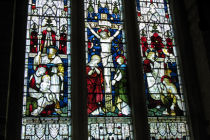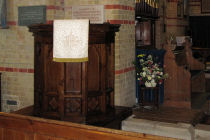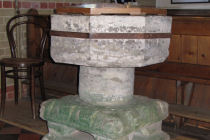 |
 |
 |
St Swithin's Church comprises the Chancel, Nave, north and south Transepts, Vestry and Bell Turret with open Belfry. The external walls are random rubble stone with dressed quoins (the cornerstones of brick or stone buildings). The window surrounds, entrance porch and upper-bell turret are in stone of a finer grain. Interior walls are in fairfaced cream bricks red bands and arches, designed to a 13th century motif. The roof is constructed with cross-braced wooden principal trusses and purlins in softwood, and clad in plain clay tiles. The Chancel: The group of stained-glass windows were presented in 1898 by Elizabeth Leigh of Yarmouth. Collectively they portray the Nativity, Crucifixion and Resurrection. Oak from the old church was used to make the Pulpit. The brass candlesticks are in memory of Revd. Abraham Peat, Vicar from 1864 to 1886. A tablet commemorates Revd. Edmund Marshall as Thorley's longest serving, and last resident vicar - 1909 to 1942. |
|
The Nave: the Royal Coat of Arms over the entrance door bears the date 9th March 1909. It was a gift from Captain RW Scott-Rogers, RN, churchwarden and a benefactor to both Thorley and Yarmouth churches. Captain Scott-Rogers' gift was linked with the induction of the Revd Edmund Marshall and it also coincided with work on the church to underpin the west wall. There are memorial tablets in the nave for Captain Scott-Rogers and Edward and Katherine Ford of Bexley, Kent. On the south wall is a drawing of the old church taken from an engraving by Tomkins of 1794. IN MEMORIAM, 1914 - 1919: the framed panel at the west end of the Nave gives the names of Twelve Thorley Men killed in the great war, as recorded on the War Memorial. The North Transept: In 1990, the finely executed tapestry of St Swithin was presented by the Hayton Family. The memorial tablet is to Neville Smith, churchwarden from 1954. The South Transept: The altar and cross were dedicated by the Archdeacon of the Isle of Wight, the Ven Geoffrey Tiarks in 1964 |
 |
|
primarily for the children who attended Sunday School. The screen was given by Mrs D'Olivera. |
|
 |
The Vestries: The old vestry is situated on the north side of the chancel. The new vestry was formerly part of the Nave. In it is a memorial tablet for WJ Barrington and his son, Churchwardens over a period of 60 years from 1845. The Jacobean alter table, now in the vestry, came from the old church in 1871. The Font: This also served the Old Church. It is probably 14th century and takes an unusual form. In 1891, Percy Goddard Stone, a local historian, claimed that the plain circular shaft and battlemented base did not belong to each other. The Church Plate: The sacramental silver plate and other plate consists of a chalice, box for bread and paten purchased in 1910 from the bequest of Harry Drake of Blakes Farm, Wellow; one other paten; a flagon; a box for wafers, given in 1984 in memory of John Haigh; and two cruets given in 1985 in memory of Cyril Henderson. A large brass offertory plate was given in memory of Mr and Mrs Harry Guy in 1913. |
|
The Organ: This was built and installed in 1871 by Forsters and Andrews of Hull. It has the old-fashioned 'tracker-action', which means that the keys and pedals cause the pipes to 'speak' via a series of wooden rods and levers. Originally it would have been hand-pumped, but this task is now done using an electric motor. The Registers: The Registers of Baptisms, Marriages and Burials with the Vestry Minutes were placed on permanent loan to the isle of Wight Country and Diocesan Record Office at Newport in 1980, where they may be referred to without charge. The Registers date from 1614. The Church Bells; Thorley's pair of medieval bells are of utmost historic importance. Because of their great age and the authenticity of their origin, they hold a unique place in the study of early bells and bell-founding in Great Britain. Understandably they have been listed for total conservation by the Council for the care of Churches. These bells served the old church in Thorley |
|
and were moved in 1871 to St Swithin where they hang in an open turret. Their approximate weights are 4cwt and 3.75cwt, with diameters 2ft 3.75 inches and 2ft 2.75 inches respectively. The bells are hung to chime on the swing. The inscription on both tenor and treble bell is; JOHANNES PECTOR ECCLESIE ET WALERANDUS TRENCHARD. John was Rector of Shalfleet in 1271 and Parson of Arreton in 1288. The Trenchards were Lords of Shalfleet and Watchingwell for three centuries. It is believed that the bells were cast sometime between 1260 and 1285. Moreover, there is a firm belief that the bells originally belonged to Shalfleet, support for this notion coming from the old rhyming couplet; 'Shalfleet poor and simple people, sold their bells to build a steeple'. The Wall of the churchyard was built, in part, of stone from the old church. The Lych gate, donated by Mrs Teevan when the church was built, was handsomely restored in 1986, thanks to the generosity of parishioners, and twin gates were added through a bequest from the Haigh family, benefactors and churchwardens for many years until 1985. |
|
War Memorial: This comprises a white marble cross that was erected after the Great War of 1914 - 1918 to commemorate the Twelve Men of Thorley who gave their lives in serving King and Country. The names and regiments of these men are:
Reginald R BAKER - Royal Fusiliers W Benjamin COURTNEY - The Hampshire Regiment Alfred H FEAVER - The Hampshire Regiment Alfred L HENDERSON - Royal Engineers William J JUPE - Royal Field Artillery Frederick PLUMBLEY - The Hampshire Regiment Allan SAUNDERS - Isle of Wight Rifles Edward F Sheath - Royal Artillery Ivor H STONE - Royal Garrison Artillery Arthur W WARD - Isle of Wight Rifles Robert H WELSTED - The Hampshire Regiment William J WELSTED - The Dorset Regiment |